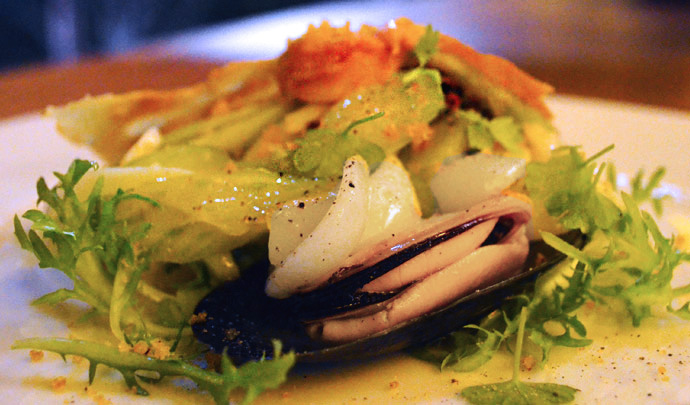There are roughly 350 different pastas. An accurate count is unlikely to ever occur due to differences in spelling and sub-classification> But one thing is sure, the rarest pasta is su filindeu from Nuoro. Its name means “the threads of God” and holding it up to the light reveals complex artistry in the overlapping cross hatches of ultra-fine dried pasta. It is also the world’s most expensive pasta, costing about $70 per pound. Prepared in sheets, su filindeu is even more dramatic when it has been colored a deep, matte black by using squid ink.
Pane Frattau
Sardinia is renowned for its bread and in Nuoro, the paper-thin pane carasau (also known as sheet music) is not only eaten fresh, but is also used in this recipe.
Ingredients
- 3 tbsp of extra virgin olive oil
- ½ onion, peeled and chopped
- 1 garlic clove, peeled and crushed
- 28 oz of passata
- fine sea salt
- freshly ground black pepper
- 4 eggs
- 2 cups vegetable stock
- 12 sheets of pane carasau
- Pecorino Sardo, grated (as needed)
Preparation
Place the oil, onion and the garlic in a medium saucepan set over a medium flame. Gently, sauté stirring often, until the onion is soft and translucent, about 10 minutes. Add the passata and 1/4 cup water. Lower the flame, cover and cook for 30 minutes, stirring occasionally. Taste and season with salt and pepper.
Poach the eggs in boiling water, one at the time, until the white is set, but the yolk is still runny, about 4 minutes. Drain with a slotted spoon and set aside.
Heat the stock in the widest stockpot you have – it should be wider than the sheets of pane carasau. Dip a sheet of bread for a few seconds to soften it, then lift it up and ease it on to a plate over a bed of marinara sauce. Top it with more sauce and some grated Pecorino. Repeat with two more layers per serving (each person gets three layers of bread), finishing with the sauce and cheese. Serve hot with a poached egg on top.
Sardinian Seafood Salad
Although the interior of Nuoro produces fantastic cheese, the coast thrives on seafood dishes.
Ingredients
- ½ lb cleaned calamari, thinly sliced
- ½ lb cleaned cuttlefish, thinly sliced
- ½ lb octopus legs
- 2 quarts vegetable stock
- 2 tbsp extra virgin olive oil
- 2 garlic cloves, lightly crushed
- 8 mussels, scrubbed and de-bearded
- 8 large clams, scrubbed
- A splash of dry white wine
- 1 celery stalk, julienne sliced
- 2 tbsp grated bottarga (mullet roe)
- 1-2 sheets pane carasau
- salt and pepper
- 2 cups salad leaves, such as endive
Preparation
Poach the octopus legs in 1 quart of simmering vegetable stock for around 40 minutes and let cool down in the same liquid. Heat the olive oil in a pan and lightly sauté the garlic cloves until soft (do not allow to color). Add the mussels, clams and a splash of white wine. Cover and cook until the shells open (discard any shellfish whose shells do not open). Remove from heat and let cool to room temperature.
Lightly poach the cuttlefish and calamari in a separate pan in remaining simmering vegetable stock for 30 seconds and then remove from heat and let them cool down in the stock.
At this time you are ready to mix all the ingredients: Cut the octopus, cuttlefish and calamari into bite-sized pieces. Mix with the clams, mussels and celery. Dress with extra virgin olive oil, salt and pepper and 2-3 tablespoons of liquid left from the mussels and clams. Place some greens on a plate; add the seafood and finish with grated bottarga. Serve with a few pieces of pane carasau on top.
Culurgiones
This unique stuffed pasta originates from Ogliastra in the Barbagia.
Ingredients
For the dough
- 5 oz plain flour
- 4 oz semolina flour
- a pinch of fine sea salt
- 5 oz of water
- 1 tbsp of extra virgin olive oil
For the filling
- 1 medium potato
- 3 tbsp of extra virgin olive oil
- 1 garlic clove, peeled and crushed
- 3 oz Pecorino Sardo, grated
- 8 mint leaves, finely chopped
- fine sea salt
- freshly ground black pepper
For the sauce
- 10 oz passata
- 2 tbsp of extra virgin olive oil
- 1 garlic clove, peeled and crushed
- basil leaves for garnish
Preparation
Place the potato in a pot and cover with cold water. Bring to the boil and cook until the potato is tender all the way through when pierced with a fork. Drain, peel, place in a bowl and mash with a fork while still hot.
While the potato is cooking, put the garlic in the oil and allow it to infuse. Next, discard the garlic and add the infused oil to the mashed potatoes. Add the grated pecorino, mint, a generous dash of salt and stir to combine. Wrap with cling film and place in the refrigerator to cool for at least one hour.
Make the dough by combining the flour, semolina and the salt with water and oil. Knead until you have an elastic, smooth ball. Wrap it in plastic wrap and allow it to rest for 30 minutes.
While the dough and filling are resting, prepare the sauce. Place the oil and the garlic in a medium saucepan set over a medium flame. Add the passata and 2 ounces of water; cover and allow the sauce to cook for 30 minutes, stirring often. Taste and season with salt and pepper.
Remove the filling from the refrigerator. Unwrap the dough and roll it out over a well-floured working surface to about 1mm thickness (not quite 1/32 of an inch thick). Cut out 3” rounds of dough. Place about 1 ½ tablespoons of filling at the center of each round, then pinch and fold the base to seal it on one side. Keep pinching and folding the extremities to seal the top of the dumpling, working as you would a braid, first on one side and then on the other, until you’ve reached the other side. Place the finished culurgiones on a floured tray while you work
Bring a large pan of salted water to a rolling boil. Working in batches, cook the culurgiones in batches for 4 minutes. Drain with a slotted spoon and ease them on to warmed-up plates over a bed of marinara sauce. Serve immediately with roughly torn basil leaves.





